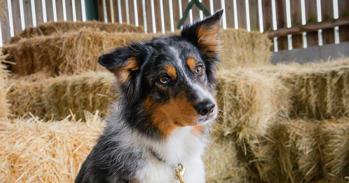
As many as a half of all short-nosed dogs such as pugs, French bulldogs and bulldogs experience breathing difficulties related to their facial structure. However, research published today by the University of Cambridge suggests that there is no way to accurately predict from visible features whether an apparently healthy pug or French bulldog will go on to develop breathing difficulties.
As many as a half of all short-nosed dogs such as pugs, French bulldogs and bulldogs experience breathing difficulties related to their facial structure. However, research published today by the University of Cambridge suggests that there is no way to accurately predict from visible features whether an apparently healthy pug or French bulldog will go on to develop breathing difficulties.
Dog breeders should also avoid using dogs with extremely short muzzles, wide faces, and thick necks.
Nai-Chieh Liu
The findings have implications for attempts to ‘breed out’ this potentially life-threatening condition.
Pugs and bulldogs have become popular breeds in recent years – the French bulldog is set to become the UK's most popular canine, according to the Kennel Club. However, a significant proportion are affected by a condition known as Brachycephalic Obstructive Airway Syndrome (BOAS) related to their head structure.
Studies suggest that for over half of such dogs, BOAS may lead to health problems, causing not just snoring but also difficulty exercising and potentially overheating. It can even prove life-threating. But as symptoms often do not arise until after the dog has begun breeding, veterinary scientists have been searching for markers that can predict whether a dog is likely to develop breathing difficulties – and hence potentially help breed out the condition.
A study in 2015 led by researchers at the Royal Veterinary College, University of London, working across many breeds suggested that dogs whose muzzles comprised less than half their cranial lengths and dogs with thicker neck girths were at increased risk of BOAS. However, a new study carried out by researchers at the Department of Veterinary Medicine, University of Cambridge, and published today in the journal PLOS ONE, suggests that these measures applied to individual breeds are not dependable for this purpose.
The Cambridge researchers took external measurements of features of head and neck shape, and of the external appearance of nostrils, together with measurements of body size and body condition score (an approximation to the degree of fatness/obesity) in just over 600 pugs, bulldogs and French bulldogs, the most numerous breeds that show this problem. Each of the dogs had also been graded objectively for respiratory function.
The team found that while the external head measurements did have some predictive value for respiratory function, the relationship was not strong, and the measurements that showed the best predictive relationship to BOAS differed between breeds. They were unable to reproduce conclusively the findings from the previous study by the Royal Veterinary College in any breed.
“It can be incredibly difficult to take measurements such as distance between eyes or length of nose accurately, even for experienced vets, as the dogs don’t keep still,” says Dr Jane Ladlow, joint lead author. “This may explain why it is so difficult to replicate the findings of the previous study or find any conclusive markers in our own.”
Neck girth was a slightly more reproducible measurement, and larger neck girth in comparison to chest girth or neck length was associated with disease in the bulldogs and French bulldogs. In male bulldogs, neck girth showed a close enough association with disease to give moderately good predictive accuracy for the presence of clinically significant BOAS.
The best measure identified by the Cambridge team was the degree of nostril opening, which proved a moderately good predictor of the presence and severity of BOAS in pugs and French bulldogs, and was also a useful marker for disease in bulldogs.
Altogether the variables measured, when combined, gave an 80% accuracy in predicting whether or not dogs will have BOAS, the difficulty of taking some of the measurements accurately, and the need to make multiple measurements and combine them in order to produce a prediction means that the researchers would not recommend using them as a guide to breeding.
Dr Nai-Chieh Liu, first author of the study, says: “Breeding for open nostrils is probably the best simple way to improve these breeds. Dog breeders should also avoid using dogs with extremely short muzzles, wide faces, and thick necks. These traits are all associated with increased risk of having BOAS.”
Joint lead author Dr David Sargan adds “At this moment there is no conclusive way of predicting whether any individual pug or bulldog will develop breathing difficulties, so we are now looking for genetic tests that may help breeders get rid of BOAS more rapidly.
“The best advice we can give to owners of short-nosed dogs is to make sure you get your dog checked annually for any potential difficulties in breathing, even if you have not yourself observed any in your dog, and to keep your dog fit and not let it get fat.”

The text in this work is licensed under a Creative Commons Attribution 4.0 International License. For image use please see separate credits above.



